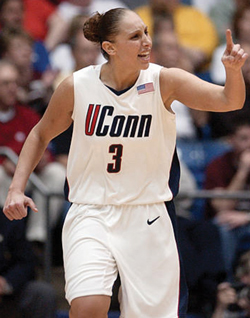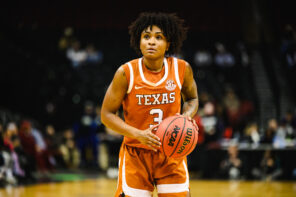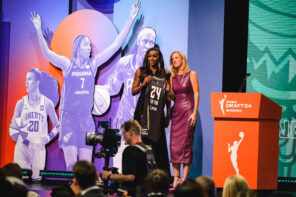By Scott Mammoser
UConn versus Villanova. UConn versus Georgetown. UConn versus Seton Hall, Providence and St. John’s. Those matchups just roll off the tongue and go together like peanuts and pad Thai or whipped cream on a hot fudge sundae. UConn taking on East Carolina, Tulane and Central Florida – not so much.
That’s why the university’s recent decision to return to the Big East Conference is such an exciting move for basketball fans. But how does some of its most-accomplished alumna feel about the transition from the American Athletic Conference, where UConn has called home since 2013.
“You take pride when you play in the Big East,” said Phoenix Mercury guard Diana Taurasi. “It’s tough, it’s East Coast, it’s grimy, you need to grind out wins on the road. It’s going to be good for us going back there in a lot of ways. Obviously, the football team takes a back seat in a lot of ways, but hopefully, they get back on track too.”
Taurasi appeared in four Final Fours and won three-consecutive national titles to end her career. She graduated in 2004, one year before Marquette and DePaul realigned from Conference USA. She reminisced of the atmosphere, when her team’s 70-game winning streak evaporated at the hands of Villanova in 2003.
“More than anything,” she said, “my junior year in the Big East Tournament at Rutgers, we played Villanova in the final. We had the Rutgers fans against us, and we had the Villanova fans against us, and we ended up losing that final. It was like, ‘This is hard. This is a hard league to win and to play in.’ That’s why for so long, the Big East was so dominant, with the players and championships.”
Renee Montgomery’s freshman season coincided with the league’s expansion to 16 in 2005 and culminated with an undefeated national championship in 2009. A member of two WNBA title winners in Minnesota, she currently starts at point guard for the Atlanta Dream.
“I love it!” Montgomery was quick to answer. “I love it because the Big East has something very special going on. At a certain point, when I was in school, we had two of the four teams in the Final Four championship game. I just think the Big East held its own, so I’m glad to see we can build it back.”
Montgomery remembered some of the top players in the league during her era, including Kyle Lowry from the Villanova men’s team, who just won an NBA title with the Toronto Raptors.
“Those were big-time universities,” Montgomery said. “They were holding their own weight at Villanova – they were that Kyle Lowry group. There was Rutgers, with Essence Carson, Kia Vaughn, Cappie Pondexter, and Epiphanny Prince. We had tough competition in conference, and I think that helped us in the tournament.”
Tiffany Hayes won national titles in 2009 and 2010 before the Dream selected her 14th overall in the 2012 WNBA Draft. This season, she is leading Atlanta with about 13 points per game.
“All I knew when I was there was the Big East,” Hayes said. “We did really well in the Big East, I think we were one of the best teams there, and it was a pretty good conference. I think it’s great they are bringing it back. It was always hard competition, no matter what the score looked like. The teams always fight in the Big East, and that’s something I always liked in the Big East.”
The Huskies were a charter member of the league when it debuted in 1979 and established rivalries not just in men’s and women’s basketball, but all sports. After Syracuse and Pittsburgh bolted for the ACC in 2013, the Big East’s seven non-football schools separated from those who did and claimed the name of the conference. UConn joined the newly-formed AAC with the likes of Louisville and Rutgers, who soon moved to the ACC and Big Ten. Beginning in 2020, the Huskies will reunite with the programs they made themselves a name against in the 1980s, 1990s and 2000s.
“Tiff and Nee, they know what prestige and those rivalries mean to the state of Connecticut,” Taurasi added.




